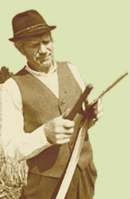Fungi in reproduction
Bellis Kullmann takes a glance into the hidden world of fungi, where researchers can observe the complex development of reproductional cycle from parasex to real sex. Sexual reproduction can be seen as regular alternation of joining of cells and meiosis in the lifecycle of an organism. The article gives an overview of the size of the genome of fungi, and its variability compared to higher eucaryots. Within the huge diversity found in the world of Fungi, we can find transitional forms ranging from parasex to sexual reproduction. However, sometimes a mushroom can lose its sexuality and turn back to a more primitive form of reproduction. At the same time, they can form mychoriza, turn into lichens or sponge upon plants, animals or humans. The extreme plasticity and fast adaptation capacity of fungi are secured by the alternation of sexual and asexual cycles as well as the cycle of parasex.
A windmill in nature?!
Ain Kull looks at the possible threats of windmills and wind parks on landscapes, flora and fauna, as well as on people. In Estonia, the rhetoric related to modern windmills is still rather new, and experience and knowledge in that field are still limited as well. The author explains the task of planning a wind park: on one hand, it should be located at a windy place. On the other hand, it would be perfect if it wasnt too much out in the open to disturb the eye.
Black alder the master of wet peatland forest
Aivo Vares thinks highly of black alder a fast-growing species that has valuable timber and enriches soil with nitrogen. However, the species has not been fully appreciated yet. The article gives a short overview of the species biology and use of timber. The latter is much used in furniture industry, but black alder is also used for water constructions (e.g. in Venice), since it does not rot easily in water.
Essay: the sign of biorisk by Kalevi Kull
Eesti Loodus enquires
Urmas Tartes feedback on the impact of animal photo contest at Estonian nature photographers.
Indrek Rohtmets writes about the niche of NGO Loodusajakiri (Nature Magazine).
The half century of the Võrtsjärve biological station
Tarmo Timm recalls the creation and development of Estonian center of limnologists and hydrobiologists. The researchers of the station do not focus on Lake Võrtsjärv alone, but on all Estonian inner water bodies. The best times of the station where in the 1980ies. Currently, the station belongs to the University of Agriculture.
Kesselaiu landscape protection area half a century in oblivion
Uudo Timm introduces the natural values and the protection rules of a protected area founded already in 1938. The islet Kesselaid is located between mainland and the island of Vormsi. While in Soviet times the islet was untouched, the nowadays tourists are the more intrigued by it. The uncontrolled flow of tourists is currently the biggest threat for the islet.
European rarities in Estonia: Black Stork
Urmas Sellis describes the bird of the underworld, the reasons for its declining numbers and contemplates on its possible future. The bird prefers primeval forests, which are less and less common in our country. Elsewhere in Europe the black stork has adjusted to the changes in landscapes, but not so in Estonia.
Interview: Biological science is on the rise
Toomas Kukk has interviewed Meelis Pärtel, professor of botany.
Alvars are the pearls of Estonia
Iiro Iikonen finds that Nature 2000 and investments from the European Union can help to maintain one of Estonias biggest treasures one fifth of the worlds alvars. The author, a Finn, takes an outsider view of the possibilities to maintain the ecosystem as well as people living around these ecosystems.
Wales is enjoyable in every season
Siiri Merila-Hubbard takes the reader to Wales the land with lovely nature, fantastic landscapes and exciting cultural heritage. The main topic in Wales is the weather: will it rain or not? However, even bad weather can not take away the beauty of the mountains, coasts and cliffs.
Hiking trail through the silence of Luhasoo bog
Katre Palo advises to visit a landscape protection area next to the border of Latvia and take a hike on a 4.5-km nature trail. In the center of the bog one can find Lake Mustjärv a lake with dark water.
A small fungus attacks big trees
Sulev Järve warns against one of the most dangerous fungi in urban green areas. Kretzschmaria deusta, a species found all over the world, attacks mostly damaged and weakened deciduous trees. Intensive traffic weakens trees a lot and therefore the fungus is most spread in areas of intensive traffic.
| 

![[IN ENGLISH]](images/gb.gif)






